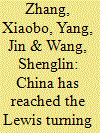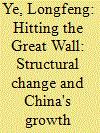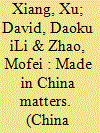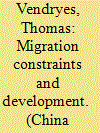| Srl | Item |
| 1 |
ID:
110501


|
|
|
|
|
| Publication |
2011.
|
| Summary/Abstract |
In the past several years, labor shortage in China has become an emerging issue. However, there is heated debate on whether China has passed the Lewis turning point and entered a new era of labor shortage from a period of unlimited labor supply. Most empirical studies on this topic focus on the estimation of total labor supply and demand. Yet the poor quality of labor statistics leaves the debate open. In this paper, China's position along the Lewis continuum is examined though primary surveys of wage rates, a more reliable statistic than employment data. Our results show a clear rising trend of real wages rate since 2003. The acceleration of real wages even in slack seasons indicates that the era of surplus labor is over. This finding has important policy implications for China's future development model.
|
|
|
|
|
|
|
|
|
|
|
|
|
|
|
|
| 2 |
ID:
168357


|
|
|
|
|
| Summary/Abstract |
China is facing slowing growth rates, slowing rates of rural to urban migration and resistance to reforms that would liberalize internal migration restrictions (Hukou). We use a two sector Ramsey growth model and show that, allowing for endogenous capital accumulation, labour reallocation has accounted for approximately one fifth of China's per capita GDP growth over the last 30 years, and that Hukou reform could generate a significant boost to China's per capita GDP growth over the next decade. Our results contrast with conclusions drawn from the traditional growth accounting literature on labour reallocation effects in China because our simulation method allows for endogenous capital accumulation dynamics.
|
|
|
|
|
|
|
|
|
|
|
|
|
|
|
|
| 3 |
ID:
163328


|
|
|
|
|
| Summary/Abstract |
We show that the integration of Chinese labor into the global labor market has played a key role in the global labor share decline since the late 1970s. Several key institutional changes, including the “reform and opening-up” that began in the late 1970s and China's entry into the WTO in 2001, accelerated this process. We build a two-country dual economic model to explain how labor shares decline in labor-intensive and capital-intensive countries simultaneously. Our empirical results show that the integration of Chinese labor significantly affects the global labor share, mainly through the channel of international trade and especially processing trade business.
|
|
|
|
|
|
|
|
|
|
|
|
|
|
|
|
| 4 |
ID:
110509


|
|
|
|
|
| Publication |
2011.
|
| Summary/Abstract |
Rural-urban migration flows are a crucial corollary of economic development. The adverse or beneficial effects of internal migration, for sending as well as receiving areas, and the definition of optimal migration policies, have remained much discussed issues since the seminal works of Harris and Todaro (1970). This debate is especially acute in China where the "household registration system" (hukou) acts as a strong constraint on individual migration. This paper aims to assess the consequences of hukou through a simple model of a developing dual economy with overlapping generations. Contrary to existing studies focused on the contemporaneous allocation of economic resources, it deals with the dynamic consequences of migration flows and migration policies. It shows that, in fairly general circumstances, hukou-related migration constraints can actually hasten development, understood as the transfer of the labor force to the modern sector, driven by capital accumulation. The hukou system could thus be one of the causes of the extremely high Chinese saving rate and of the high pace of Chinese development. Insights from the model are confronted with stylized facts from the Chinese development, and theoretical results are especially consistent with the effects of the 2001 "towns and small cities" reform.
|
|
|
|
|
|
|
|
|
|
|
|
|
|
|
|
| 5 |
ID:
147443


|
|
|
|
|
| Summary/Abstract |
The departure of a factor in excess supply in a non-traded rural sector leads to a Rural-led Exchange Rate Real Appreciation (RERA), in a dual economy setup. The RERA highlights for the first time a potential link between intra-national factor movements and real exchange rates. In China, where there is excess labor employed in the production of (largely) non-traded rural goods, we attribute around one third of the recent appreciation of the real exchange rate – defined as the relative price of nontradables – to a RERA effect.
|
|
|
|
|
|
|
|
|
|
|
|
|
|
|
|
| 6 |
ID:
117919


|
|
|
|
|
| Publication |
2013.
|
| Summary/Abstract |
It has been widely recognised that China has had a large pool of surplus labour. However, despite its significant implications for wage levels and the Chinese economy, the current debates yield conflicting results as to whether a Lewis turning point has been reached. This paper clarifies a theoretical issue about the mechanisms of surplus labour absorption, subsequently indentifies two Lewis turning points and examines the factors that affect the reaching of these two points. It then applies the framework to China to study the labour absorption process and examines some of the likely implications of the removal of the Hukou system in terms of welfare and economic performance.
|
|
|
|
|
|
|
|
|
|
|
|
|
|
|
|